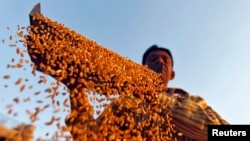As far as agricultural genome research goes, this may be the best thing since sliced bread - wheat bread, that is.
An international team of scientists on Thursday unveiled a genetic blueprint of wheat in an accomplishment that may help guide the breeding of varieties of the vitally important food crop that are more productive and more hardy.
Researchers who are part of the International Wheat Genome Sequencing Consortium, formed in 2005 by a group of wheat growers, plant scientists and breeders, unveiled what they called a chromosome-based draft genome sequence of bread wheat, also known as common wheat.
The work makes it easier to identify genes controlling agriculturally important traits like yield, disease and pest resistance and drought tolerance, according to FrDedDeric Choulet, a plant genomicist at the French National Institute for Agricultural Research (INRA), one of the lead researchers.
“Bread wheat is a major crop. It is the most widely grown crop around the world and is a staple food for one third of the human population. However, its genome is so complex that it has always been perceived as impossible to sequence,” Choulet said.
“Wheat improvement is crucial to ensure food security and the development of sustainable agriculture in a context of climate change and growing population,” Choulet added.
The large, repetitive nature of the wheat genome has complicated efforts to decipher it.
The research, published in the journal Science, encompasses nearly all the genes of bread wheat, whose scientific name is Triticum aestivum, and roughly 60 percent of the whole genome. The researchers estimate that wheat has about 124,000 genes and that its genome is 40 times larger than rice and seven times larger than corn, both of whose genomes have been deciphered.
The wheat genome also is more than five times larger than the human genome, the researchers noted.
The new work also included a comprehensive look at the largest of wheat's 21 chromosomes.
The researchers underscored the need to develop new and better wheat varieties.
“The world is facing enormous challenges with a human population projected to rise to over nine billion by 2050. Food production will need to increase by over 50 percent without expanding land use in the face of a changing climate and with dwindling availability of fertilizers, water and effective pest treatment,” the consortium said in a statement.
The researchers noted that wheat is a versatile plant that can be grown in a range of environments and that its grain can be stored easily and turned into flour to make a lot of different kinds of food.
The consortium has set a goal of finishing the full genome within three years.
“We have a clear path forward for completing high quality sequences of all bread wheat chromosomes,” said Kellye Eversole, the consortium's executive director.
The consortium said it has been a challenge to secure funding for the effort in part because investment in wheat research is generally lower than for some other major crops despite its importance as a food source.









